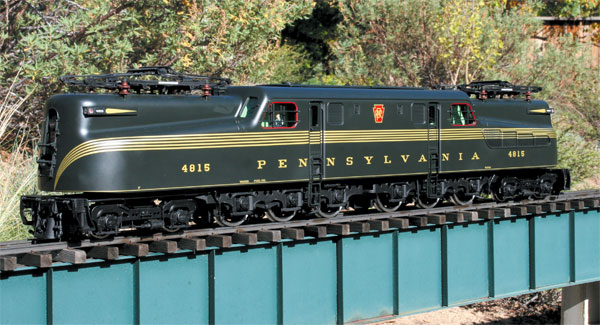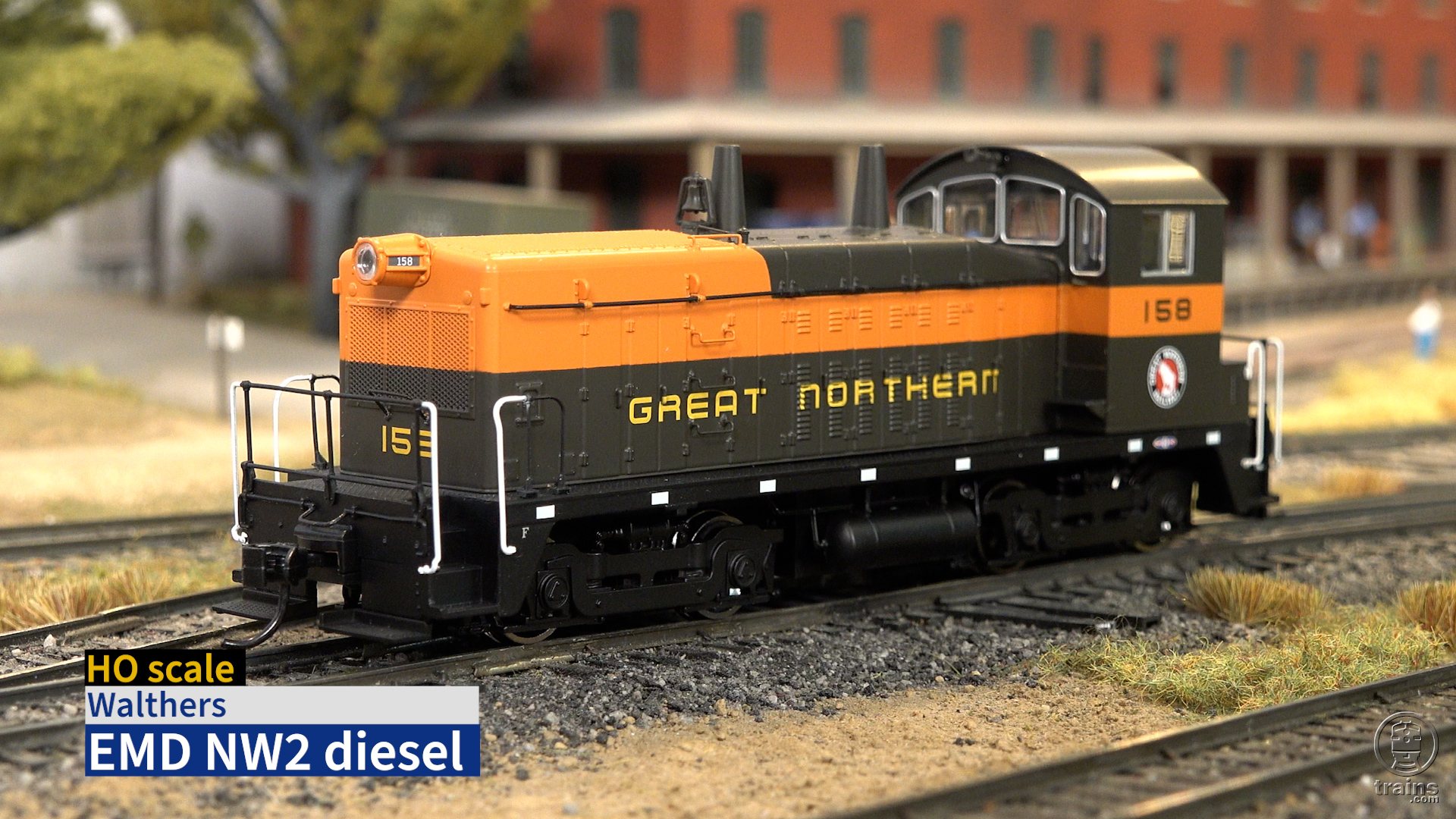1:29 scale, gauge 1, GG-1 locomotive
USA Trains
PO Box 100
Malden MA 02148
Check with your local dealer for price and availability
Web site: www.usatrains.com
All-metal model of Pennsylvania Railroad GG-1 electric locomotive; die-cast body and trucks; motorized pantographs; dual motors; steam exhaust unit; detailed cab interior; operates on regular track power or on DCC using QSI Quantum System (DCC decoder built in); will negotiate 4′-radius curves; all axles sprung; opening cab doors and windows and end doors; full cab interiors with crews; full brake gear (dummy); sound system included; available in all
historic paint schemes. Tractive effort, 148 oz., or enough to haul about 118 average freight cars; current draw at full slip, 2 amps. Weight of locomotive: 36 lbs. Dimensions: length over end beams, 31 3/41″; width: 4″; height over lowered pantograph, 6 1/2 “. In 1:29 scale, this works out to 76’9″ x 9’8″ x 15’9”
Pros: Highly detailed model; excellent fidelity to prototype; excellent finish; beautiful, working pantographs; will run on track power or overhead; fully functioning sound system included; DCC decoder included; will run on analog or DCC power; superb slow-speed operation; second drop coupler, working coupler, and Kadee mounting pads included; built-in inertia (momentum) system (can be overridden); impressive model
Cons: Complicated and confusing instructions; some sound-control problems; pantographs cannot be operated manually
USA Trains’ model borders on the spectacular. Detail-wise, it is exceedingly close to all of the prototype photos I have looked at. Little has been omitted. The pantograph assemblies are works of art. But let’s start at the beginning.
The locomotive arrived in a cardboard box that weighed a whopping 91 pounds. Inside I found a special set of instructions on how to unpack the engine. In the outer box is another cardboard box, cradled in various foam bits. Inside this is a beautiful wooden box, finished like a piece of furniture. Once this was extracted, I opened the large door on one side. The instructions told me to unscrew two screws that secure the inner wood-and-metal frame that holds the engine. When these were out, this inner frame-top and bottom wooden plates held apart by metal standoffs-could be carefully slid out the wooden box. On the top plate are six wing nuts and a metal handle, also held on by wing nuts. These all have to be removed before the top plate can be lifted off.
Now here’s the fun part. You take that metal handle and, with special stand-offs, you screw it directly into the top of the locomotive. With this, you can then lift the 36-pound engine out of its cradle like a suitcase-I kid you not. Once it’s placed on the track, you then remove the handle, which screws into holes in recesses in the cab roof, and put the special roof panels provided in their place.
In one of the roof recesses are the control switches. There are seven of them that variously control pantograph operation, sound volume, lights, steam (smoke) unit, track-or-pantograph power pickup, and DC or DCC operation.
On the track, the engine looks truly wonderful. All of the cab and end doors open, as do the cab windows. Through those windows you can see the complete cab interior detail. The pantograph assemblies are highly detailed and prototypically accurate. As supplied, there is a prototypical, scale-size drop coupler at one end and a larger, USA Trains knuckle at the other. An additional coupler of each variety is supplied, so you can have any combination you like. And if you prefer Kadees, mounting pads for these are also supplied. Even the wheel flanges seem less that what we are used to. The only slightly jarring thing are the shiny wheel rims, but a coat of paint could easily solve that problem.
Our review sample is painted Brunswick green with the familiar five-stripe graphics. Paint and lettering are flawless. The engine is available in all Pennsylvania paint schemes, as well as Penn Central, Conrail, and Amtrak, all of which are prototypically correct.
A lot of what this model is about is electronics. It comes with a QSI “Quantum System” sound system, with both analog and DCC decoders. There’s a lot that the engine will do right out of the box, and a lot more that you can make it do in its more advanced modes, both in DCC and analog.
The engine is provided with two instruction books. The eight-pager from USA Trains contains only rudimentary information about locomotive maintenance, a list of features, and a little more. The 32-pager from QSI has all of the information that you really need to know. If you’re not a techno-junkie, the book is slow going. However, everything you need to know to get up and running is on the inside front cover (basically, “put the engine on the track and go”). After that, there are a lot of features available-far too many to go into here. You’ll need a standard power pack (a list of approved packs can be found on QSI’s web site, www.qsindustries.com) to properly operate the engine, one with a good, old slide switch for direction control. You use this switch, not only for direction, but to honk the horn at will and sound the bell. By accelerating and decelerating slowly, you can bring into play a variety of other sound effects automatically. There are ways to keep the sound going while reversing the engine, too (if you turn the power all the way off, the sound stops abruptly). In short, this is a complicated system that will take time and study to get the most out of. Most of the features that are available with DCC are available with analog, too. For some, though, you have to buy a separate QSI controller.
In testing the engine, I put it on the track and turned on the power. There is a built-in inertia system (which can be overridden) that prevents jack-rabbit starts. If you turn the power on full, the engine will slowly and majestically start to move, with all of the appropriate lights shining. It makes a sound unlike any other engine that I have heard. We are told that the sound was recorded from an actual GG-1 in operation. It’s pretty cool. I found the top speed to be somewhat less than I expected, as these engines were high steppers (others I spoke to did not have this problem). Slow-speed operation was all you could ask for. It will creep along at a snail’s pace if you want it to. It has more tractive effort than you’ll probably ever need-enough to haul nearly 120 freight cars. The engine would handle a 15-car train of USA’s Pennsylvania coaches without even breathing hard.
I tried the horn and bell, but with mixed luck. To operate the horn, while the engine is in motion you throw the reversing switch on the pack. This does not affect the engine’s operation, but the horn comes on-after a little delay. To turn it off, you switch it back. I found it impossible to get a truly short blast, and the delay was somewhat disconcerting. To turn the bell on, you again use the reversing switch. This time you switch it back and forth quickly, which activates the bell. To turn it off, you repeat the process. For me, this worked sometimes, but not consistently.
Pantographs are controlled by the switches under the roof panel. The instructions in the book did not seem to match with reality and were confusing. There’s a push-button switch for each pantograph. What I found was that if you press the switch and let up on it, the pantograph will go up. Press it again and it will go down. The book says that if you press the button while the pantograph is rising, it will stop. Press the button again, and it will continue in the same direction. I found that if you press the button while it is rising, it will immediately go back down. There must be power in the track for the pantographs to rise. To prevent the engine from moving, you have to hold the button down while turning on the power, then press it again to get the pantograph up. But here’s a problem: If you are running your trains from overhead power, there is no power to the rails. How do you get the pantographs up? It can’t be done manually. In fact, if you try it manually, you might break something. On our review sample, one pantograph worked smoothly, while one had a bind, which hampered its operation somewhat.
These complaints are relatively minor. Overall, this is a beautiful, fully configured, but complicated model. It is powerful, runs well, looks just right, but will certainly take a fair amount of getting to know.














